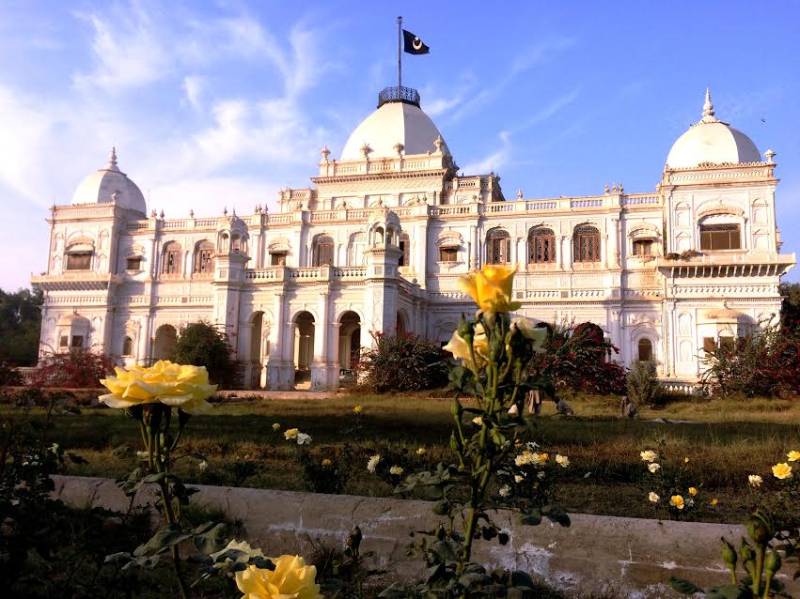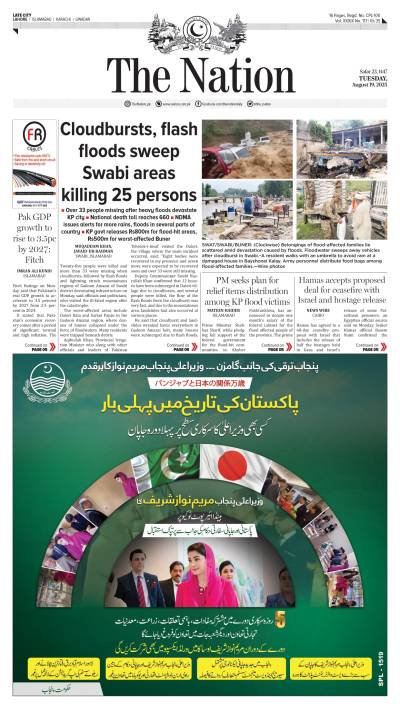What I loved most about southern Punjab were its narrow rural roads making their way through the heart of countryside along fields and orchards, connecting the lives of small villages and towns. We were driving on one such road to Ahmedpur Sharqiya leaving Derawar Fort and Cholistan desert behind.
Dera Nawab Sahab near Ahmedpur Sharqiya is home to Bahawalpur’s royal family. The Nawabs founded this small town as a retreat from the busy life of the capital. Dera Nawab Sahab is also the location of magnificent Sadiqgarh Palace, principle royal residence of the Nawab of Bahawalpur. It was our destination too. Making way through sprawling bazaars, we found ourselves driving on the road parallel to the high walls of Sadiqgarh Palace complex. I recognized the imposing gateway of the palace from a vintage picture I had come across in which Bahawalpur’s state military was presenting a guard of honor to President Iskander Mirza and Gen. Ayub Khan. The gateway is an impressive structure decorated with intricate stone carving, brick work and fresco painting. Beyond the gate and the palace grounds stood the magnificent white structure of Sadiqgarh Palace.
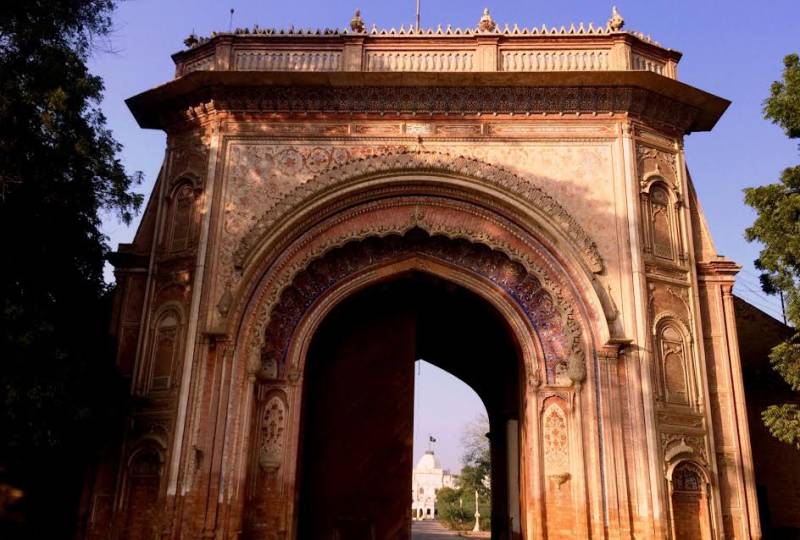
Gateway of Sadiqgarh Palace
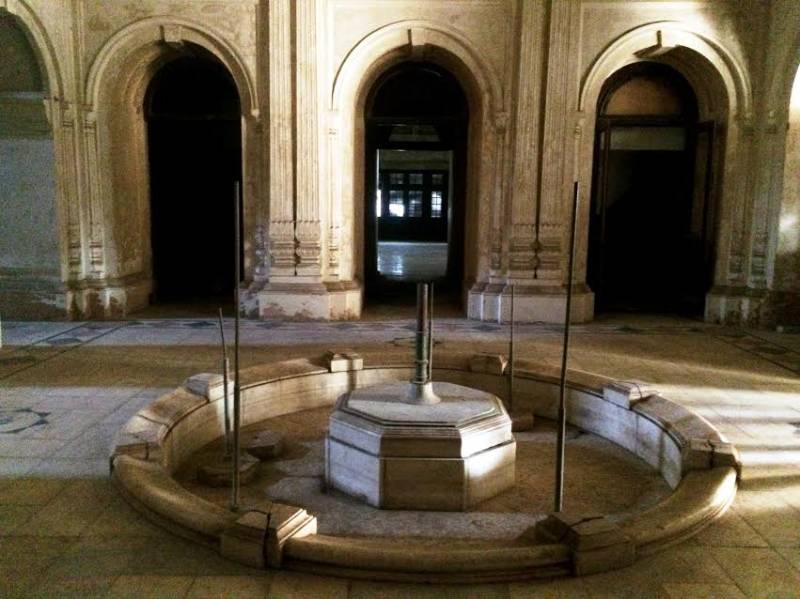
Marble fountain in the entrance hall
The palace was constructed in 1895. It has seen its days of splendor and magnificence, being the principle residence of one of the wealthiest princes of British India. The palace has ninety-nine rooms which were decorated with the most beautiful and expensive furnishings and carpets. In its heyday, the palace hosted Kings and Queens, Maharajas and Nawabs, Presidents and Prime Ministers and foreign dignitaries. Centuries old treasures of the Abbasid dynasty and wealth of the most fertile districts of Punjab were at its disposal. Its hosts were generous and entertained in a lavish manner. It was just like an oasis in the desert. Sadiqgarh offered such luxuries which were rare in those days. The palace had its own cinema theater. Its motor garages had finest models of the most expansive and fashionable cars of the age. It had an impressive library and a vast collection of antiques and valuables. It can be assumed without a single doubt that many a magical nights have unfolded within its walls and the palace has been a setting for historical moments. It remained a royal residence till a couple of decades after the princely state’s merger into Pakistan. Glories of the palace faded after the demise of the Nawab in 1966. It had to be abandoned due to an ongoing litigation regarding its rightful ownership between the descendents of Sir Sadiq Muhammad Khan Abbasi, the last ruling Nawab of Bahawalpur. The palace lost its remaining glow in years of disuse and abandonment.
Sadiqgarh presents a desolate picture of lost glory and ravages of changing times. Once vast gardens of the palace have now been shortened by erecting ugly walls. The remaining gardens are unkempt and neglected with overgrown grass and untended trees. A couple of gardeners were working quietly beside the roses and rather looked like ghosts of some 19th century gardeners. The garden is divided into four sub gardens on the Persian chaharbagh design. There is a handsome arched pavilion at the center. Artificial roses of different colors were planted in the flower beds of each garden. We park the car in the portico. Palace keys had been entrusted to a simple local man who knew nothing about the palace except that he must never open locks for anyone. He had inherited the key after his father’s death a couple of months ago. My excellent guide Suhail conducted parleys in his usual sweet Seraiki and lured the man into opening the lock for us.
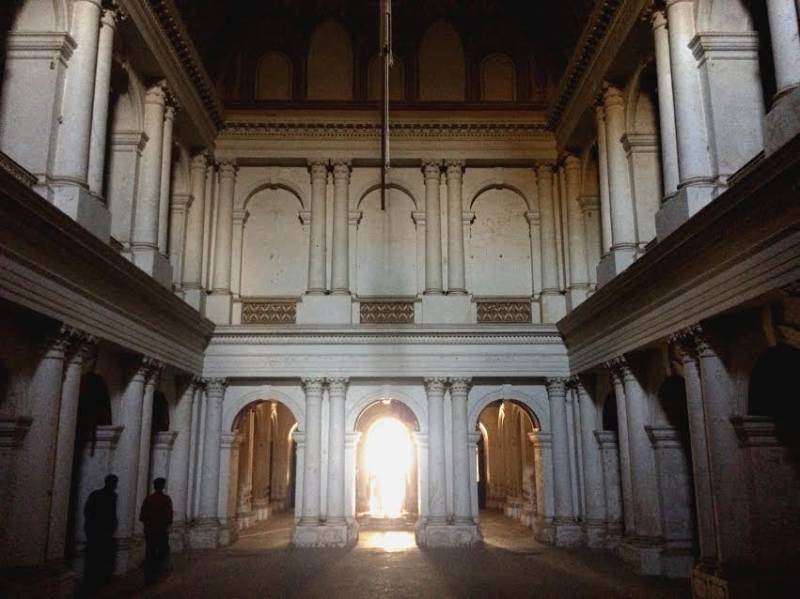
Durbar Hall
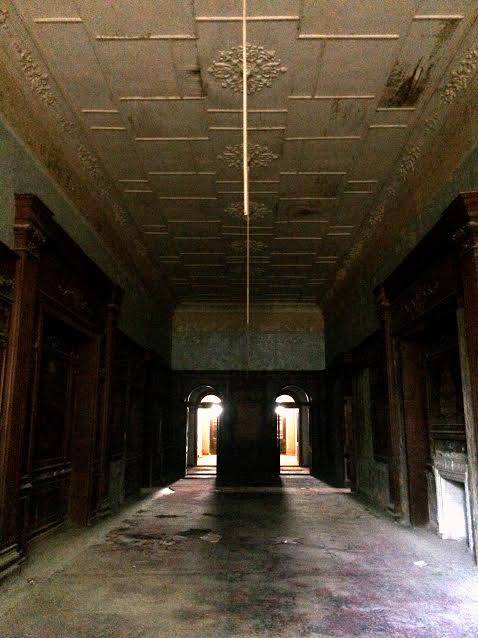
Dining Hall
Interior of Sadiqgarh Palace was a semi dark world of forgotten glory. There was a silent marble fountain in the entrance hall and beyond the three arches was the great durbar hall, robbed of its beauty and pushed into the dark annals of oblivion. When the palace was abandoned, it was stripped bare of all its furniture and precious decorative articles including the massive chandeliers hanging from the high ceiling of the durbar hall. Remains of torn curtains on the arches, withered carpets and the great mirror of the durbar hall was all that remained of the great palace. History tells that the huge durbar hall mirror which was higher than a single story of the palace was ordered from London. It was shipped to Karachi but there was no way of transporting it up to Bahawalpur. To solve the problem, the Nawab ordered extension of all platforms from Karachi to Bahawalpur and doubled the railway track. The giant mirror was placed behind the royal throne and reflected the pomp and show of the entire durbar hall in its full regalia. Bahawalpur’s merger into Pakistan and death of the dynasty were reflected in the mirror. It also witnessed ruining and looting of its royal home. Today, it reflects nothing but darkness. The mirror remains at the palace because it was too grand for the looters to carry.
Darkness of the hall was pierced by the light coming from a window high up in the ceiling. Exquisite design of the ceiling and coat of arms of the princely state of Bahawalpur were visible in the scarce light. There is another hall parallel to the durbar hall approached by several entrances. It served as the dining room. Its wooden interior and classy ceiling were past their peak time. Fireplaces had gone cold forever. There were several other rooms along the dining hall which may have been used as sitting or waiting rooms or perhaps to play billiard or snooker. There’s even an antique elevator in the entrance hall. Palace kitchens were in the far left corner. There are extensive basements under the palace.

Sitting Room
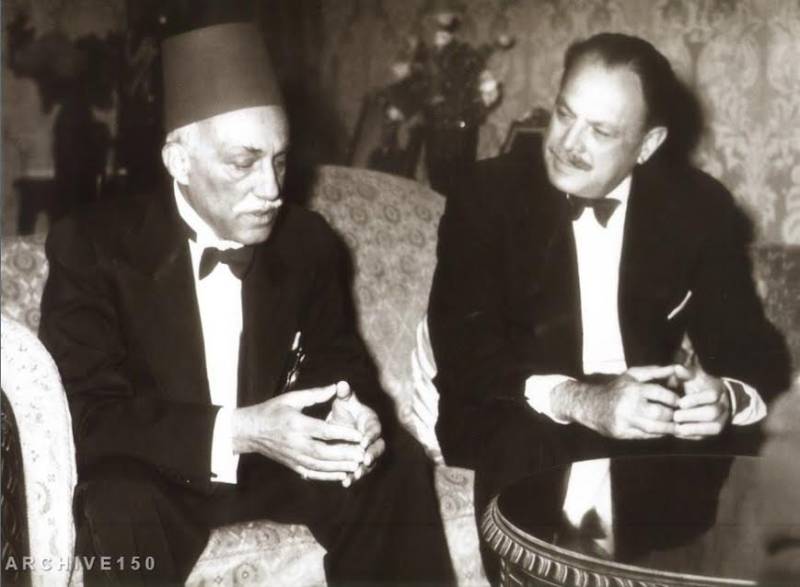
Sir Sadiq Muhammad Khan Abbasi, the last Nawab of Bahawalpur with President Gen. Ayub Khan

President Iskander Mirza receives a guard of honor at Sadiqgarh Palace
Most exquisite of the ninety nine rooms of Sadiqgarh is the Turkish room towards the left of the durbar hall. The caretaker introduced it as the Sheesh Mahal and he wasn’t exaggerating. The roof and walls of this room were decorated with small mirrors beautifully arranged in geometric patterns, alongside floral frescos on the walls. Stain glass was used in the windows. There was a dry marble fountain in the floor. The room of mirrors was in complete darkness. It lit up with the beam of my flashlight and unfolded the magic within. Nawabs of Bahawalpur were truly, the Mughals of their time.
The caretaker expressly forbade us to explore the first floor of the palace. It looked haunted enough and we were easily discouraged. The caretaker and Suhail went towards the main door to argue with a party which was trying to enter. In the meantime, I stood on Nawab’s throne in front of the mirror and tried to contemplate the terrible beauty my senses had been exposed to in the past half an hour. I felt at a complete loss of words. Sadiqgarh made me incredibly sad. History is packed with conquerors destroying history and heritage of the conquered but Bahawalpur’s royal treasures were plundered and destroyed by the royal family itself. I tried to imagine the palace in its glorious days. Durbar hall showered in the light of its massive crystal chandeliers, floors hidden under finest of Persian carpets, the shining grand mirror reflecting regalia of the court, the Nawab in his royal robes and crown, sitting on a gold chair, courtiers seated in the hall in their court uniforms and scarlet fez caps, sharp looking British officers and their beautiful wives waltzing to the haunting tunes of orchestra, begums in traditional attire and bedecked in jewelry from head to toe, witnessing the court proceedings from behind the veil. It was a world too beautiful to be true. As I came back to reality, there was nothing but silence and darkness in the durbar hall.
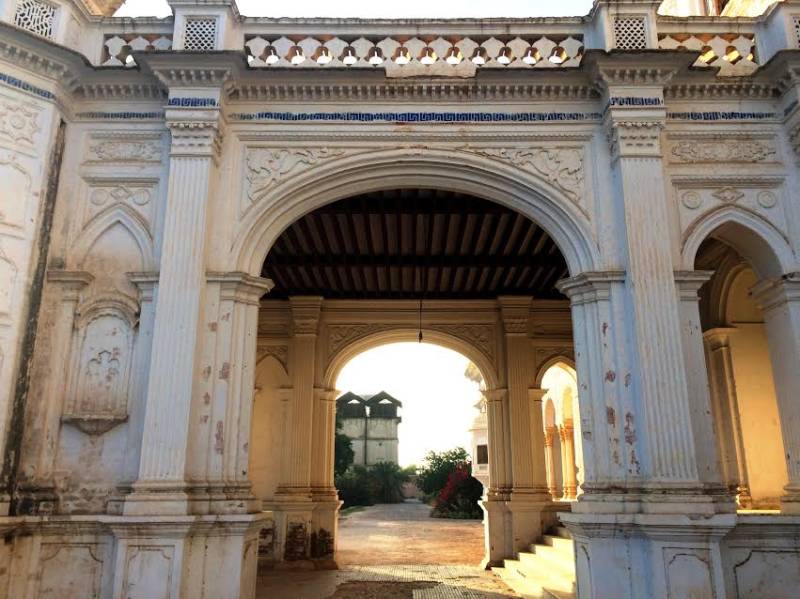
Palace portico
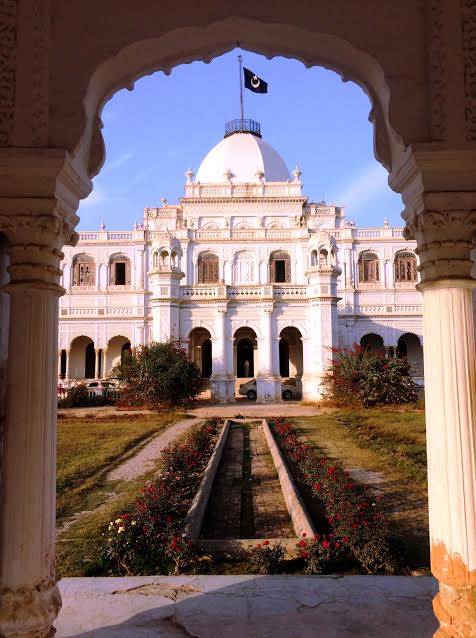
Palace from the garden pavilion
Out in the garden, one gardener tempted me to visit the royal motor garage in the palace compound. Nawab sahab’s personal cars are still parked in it, but in a very desolate condition. I would’ve loved to visit the garage but I had to decline because time was really short and I had to see the city of Bahawalpur before sunset. Rumor has it that the palace also contains a number of royal cannons which are worth looking at.
Sadiqgarh Palace is yet another historical treasure which is completely ruined and wasted. Princely states in the Subcontinent couldn’t continue living in delusions of grandeur and had to adjust with the changing times. All over India, palaces and forts have been converted into revenue generating hotels, museums and tourism sites. One fine example is Falaknuma Palace of Hyderabad Deccan. It served as a royal guest house in the time of Nizam. The beautiful palace has been converted into a luxury hotel while the present nominal Nizam continues residing in the principle Chowmahalla Palace. Even Taragarh Palace, Nawab of Bahawalpur’s summer residence at Palampur, Himachal Pardesh which was acquired by Maharaja Kashmir in 1951, has been converted into a heritage hotel. Bahawalpur House in New Delhi serves as National School of Drama. On the contrary, the royal family of Bahawalpur has lost all its beautiful palaces over time. Palaces in the city have been sold off to the military. Derawar remains ruined and unmaintained and Sadiqgarh was destroyed by the family feud and decades of litigation. Converting palaces into hotels is a fine way to preserve these historical treasures. Bahawalpur’s priceless heritage can be restored to its former glory in this way. It awaits its savior to this day.
Continued…

